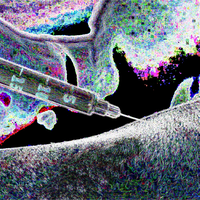| Tryptamine | |
|---|---|
| Salts [] | |
|---|---|
| Tryptamine hydrochloride | |
| Molecular structure via molpic based on CDK |
| Physical properties [] | |
|---|---|
| Molecular mass | 160.22 g/mol [1] |
| Melting point | 114 - 119 °C [1] |
| Predicted LogP | 1.6 [1] |
| Structural Identifiers [] | |
|---|---|
| Molecular formula | C10H12N2 [1] |
| IUPAC name | 2-(1H-indol-3-yl)ethanamine [1] |
| SMILES | C1=CC=C2C(=C1)C(=CN2)CCN [1] |
| InChI | InChI=1S/C10H12N2/c11-6-5-8-7-12-10-4-2-1-3-9(8)10/h1-4,7,12H,5-6,11H2 [1] |
| InChIKey | APJYDQYYACXCRM-UHFFFAOYSA-N [1] |
| Toxicity [] | |
|---|---|
| LD50 | Rat: - intraperitoneal: 223 mg/kg Mouse: - intraperitoneal: 100 mg/kg - subcutaneous: 500 mg/kg |
Tryptamine
Tryptamine (also known as 2-(1H-Indol-3-yl)ethanamine, 3-(2-aminoethyl)indole, 1H-Indole-3-ethanamine, 2-(3-Indolyl)ethylamine, Indole, 3-(2-aminoethyl)-, 2-(1H-Indol-3-Yl)Ethan-1-Amine, β-(3-Indolyl)ethylamine, 3-[2-Aminoethyl]indole, RefChem:900684 or 200-510-5) is a
Chemistry
Salts []
Tryptamine is typically found in the form of its hydrochloride salt.
Stereochemistry []
Tryptamine is a achiral mixture
See also []
External links []
References []
National Center for Biotechnology Information. PubChem Compound Summary for CID 1150, Tryptamine. Accessed October 10, 2025. https://pubchem.ncbi.nlm.nih.gov/compound/1150
U.S. Food and Drug Administration; National Center for Advancing Translational Sciences. Tryptamine. UNII: 422ZU9N5TV. Global Substance Registration System. Accessed October 10, 2025. https://gsrs.ncats.nih.gov/ginas/app/beta/substances/422ZU9N5TV
 Anodyne
Anodyne